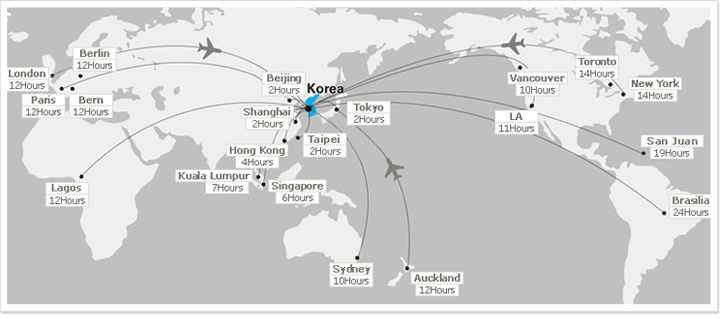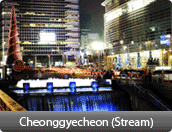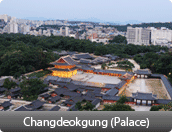| Seoul, the Capital of Korea |
Seoul has been the capital of Korea for about 600 years, since the time of the
Joseon
Dynasty (1392-1910). Seoul was referred to as "Han Yang" during the
Joseon Dynasty, but
after the liberation from Japan in 1945, the newly founded
Republic of Korea officially
changed its capital city's name to Seoul. Seoul has
developed into a bustling metropolis,
acting as the hub for political, economic,
social, and cultural matters. The Han River runs
through the heart of the city.
The river divides the city in two; the northern part of the city is a
focal point for
culture and history, while the southern part is well known for its business
district.
Seoul has hosted many international events including: 1986 Asian Games, 1988 Olympic
Games and 2002 Korea/Japan FIFA World Cup. The success of these
events has shown
people that Korea is truly an international city. |
 |
|
|
 |
|
| Easy Access |
Seoul is easy to access through the Incheon Airport as an Asian hub and world leading global airport. The Incheon airport
has over 70 airlines and operates 455 inbound and outbound international flights each day. |
 |
|
|
 |
|
| Attractions |
The city of Seoul cherishes its heritage and carefully maintains
its historical monuments, royal palaces and temples. In addition,
Seoul is a city on the move,
constantly revitalizing itself,
balancing ultra-modern
renewal with careful restoration of its
ancient buildings and preservation of the environment. The
mountains surrounding Seoul are breathtaking
and the Han
River flowing through the center of the
city offers scenic
recreational escapes. |
 |
Here in Seoul, you will find a harmony of the past and present, history and future, culture, economy and environment. Seoul is
a global city that blends
the culture of yesterday with the trends of today and the hopes of tomorrow |
|
|
 |
|
| Art |
 |
The city has over 700 museums, including the National Museum of Korea and the National Folk
Museum, which all contain countless number of articles, a number of performance centers,
such as the
Sejong Center for Performing Arts, National Theater and more, and has over 400
galleries which all the
people to see various art works. |
|
|
 |
|
| Tradition |
 |
In Seoul, various traditional or traditional aristocratic cultures can be met.
Visit Gyeongbokgung which
is the first royal palace built by the Joseon Dynasty in 1395. You
can experience the life of the past in
the Bukchon Hanok Village. |
|
|
 |
|
| Culture |
 |
Tradition is not the only thing which can be met in Seoul. There is a wide range of modern
and fusion
culture of the West and the East, along with up-to-date, cutting edge technology,
and a number of
world class performances, including "NANTA," "JUMP" and B-boy
performances. |
|
|
 |
|
| Modern |
 |
Seoul is also filled with cultural spaces in countless parts of the city center. Daehakro and
Hongdae are
known as the representative outdoor cultural spaces in Seoul and the Citizen’s park near the Hangang
(River) are also widely used as a cultural ground. |
|
|
 |
|
| Environment |
 |
Seoul is the city which takes into deep consideration the environment, centering on
Cheonggyecheon
(Stream) and the Hangang (River).. |
|
|
 |
|
| UNESCO World Heritage Sites |
 |
Seoul is home of 6 UNESCO World Heritage Sites; Jongmyo (Royal Shrine), Changdeokgung (Palace),
Jeongneung (A Royal Tomb), Taereung and Gangreung (Royal tombs),
Seonjeongneung (Tomb) and
Royal Tombs of the Joseon Dynasty. |
|
|
 |
|
| Dining |
 |
Visitors to Seoul often name Korean cuisine as one of the memorable highlights of their trip.
You can
enjoy not only Kimchi, Galbi or Bibimbap, but also taste variety of world cuisines. |
|
|
 |
|
| ※ For more information on Seoul, please visit at http://english.visitkorea.or.kr |
|
| Useful Links |
|
|
